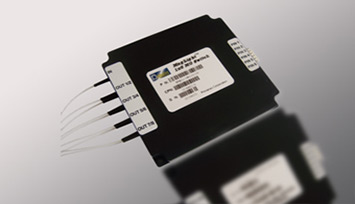| MO Tunable Time Delay※ MO Tunable Time Delay※ Products < Home |
 |
【 Product name 】 MO Tunable Time Delay
【The category 】 MO Tunable Time Delay 【Application field】 ● Phased-array antenna ● Lidar ● Measurement |
Phased-array-antenna is to individually adjust the phase of microwave signal feeding the specific antenna element within the array in such a way that the effective radiation pattern of the array is reinforced in a desired direction and suppressed in undesired directions, hence can “electronically” steer the beam without involving any mechanical movement as shown below. Such beam-steering is conventionally realized by controlling the electronic phase-shifter. However, the electronic phase-shifter would unfortunately bring the beam-steering angle changing with the frequency of feeding microwave signal, hence reduce the instantaneous bandwidth. An optical true-time delay (TTD) may help to eliminate the dependence of beam-steering angle on the microwave frequency, hence drastically increase the instantaneous bandwidth.

Beam-steering schematics of a typical phased-array antenna
An optical TTD can be implemented by multiple optical switches cascaded to form varieties of optical path lengths; switching among such different optical paths then creates desired sequence of time delays. The following schematics illustrates a typical 3-bit delay-line that consists of two 1x2 switches and two 2x2 switches with fiber loops of different lengths such as μL, 2μL, and 4μL being added in between the switches. Sequential switching of the optical devices consequently creates time delays of 0, 2μL, 3μL...7μL (8 types of delays in total).

Primanex MO switches naturally fit in such application due to its non-moving switching mechanism. MO switches’ high speed (μs-scale), ultra-long lifetime (measured to be longer than 30-billion cycles), low power-consumption (no external power required for latching) and excellent repeatability (<+/-0.01dB) make them irreplaceable in optically controlled phased-array antenna application compared with conventional mechanical or MEMS switches.
|
Item |
Unit |
Parameter |
Notes |
|
|
Channel spacing |
GHz |
25 |
50 |
Port: “Com” |
|
50 |
100 |
Ports: “Port1” and “Port2” |
||
|
Wavelength range (C-band) |
nm |
1528.77~1567.95 |
L band is available |
|
|
Clear passband |
GHz |
+/-5 |
+/-10 |
From ITU wavelength |
|
Insertion Loss |
dB |
<2.5 |
<2.0 |
Tested within Clear passband and with connectors |
|
Insertion Loss Uniformity |
dB |
<0.5 |
|
|
|
Wavelength Accuracy |
nm |
<0.02 |
<0.04 |
|
|
Isolation |
dB |
>20 |
>25 |
|
|
Passband@0.5dB |
GHz |
>+/-5 |
>+/-10 |
|
|
Passband Ripple |
dB |
<0.5 |
|
|
|
PMD |
ps |
<0.2 |
|
|
|
PDL |
dB |
<0.5 |
|
|
|
Return loss |
dB |
>40 |
|
|
|
Directivity |
dB |
>45 |
|
|
|
Optical Input Power |
mW |
300 |
|
|
|
Operating Temperature |
℃ |
0~65 |
|
|
|
Storage Temperature |
℃ |
-40~85 |
|
|
|
Fiber |
N/A |
SMF-28e+ with 0.9mm loose tube |
|
|
|
Fiber Length |
m |
1+/-0.1 |
Customizable |
|
|
Dimensions |
mm |
123 x 31 x 14.2 |
103 x 31 x 14.2 |
|
